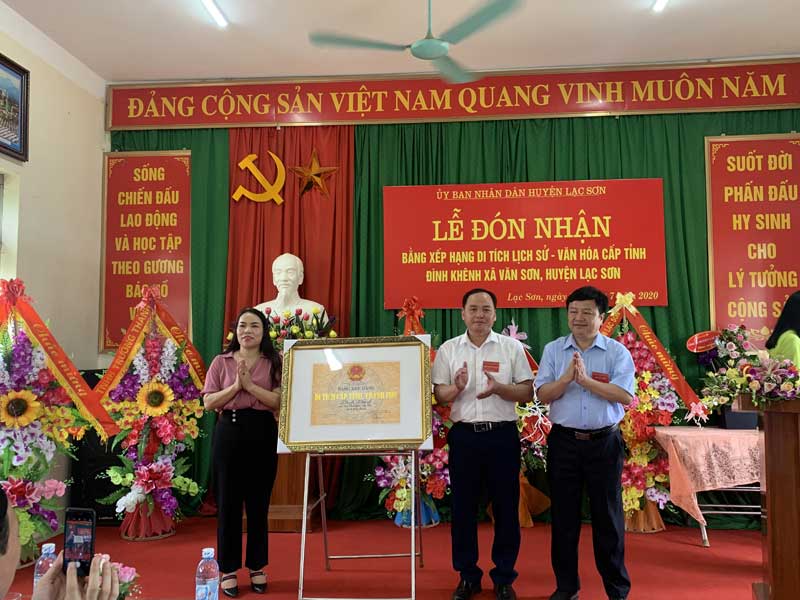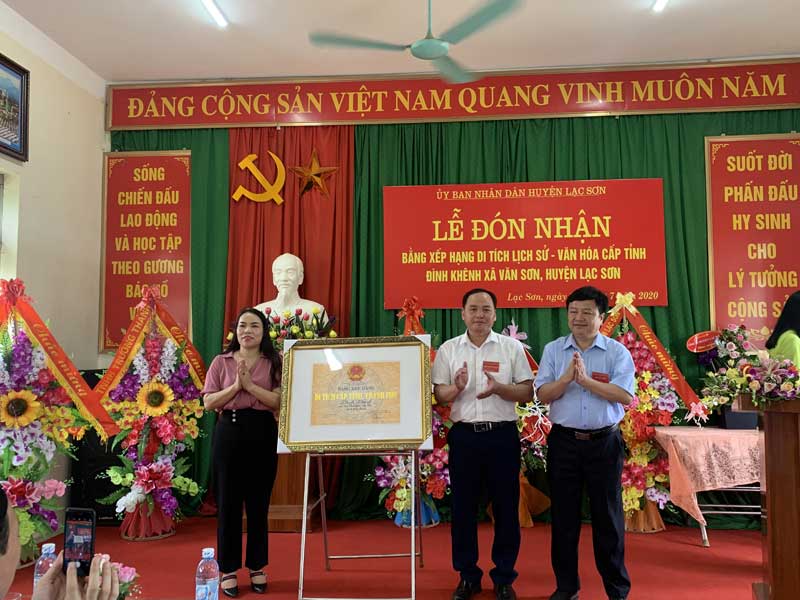
(HBO) – Khenh Communal House in Van Son commune of Hoa Binh province’s Lac Son district has been named a provincial historical – cultural relic site. The certificate presentation ceremony was held by the district People’s Committee on July 9 with the participation of officials from the provincial Department of Culture, Sports and Tourism and Lac Son district.
 An official of the Hoa Binh Department of Culture, Sports and
Tourism presents the certificate recognising Khenh Communal House as a
provincial historical – cultural relic site.
An official of the Hoa Binh Department of Culture, Sports and
Tourism presents the certificate recognising Khenh Communal House as a
provincial historical – cultural relic site.
The long-standing Khenh Communal House, located
in Rang Thien hamlet of Van Son commune, is dedicated to the persons who
contributed to the fights against invaders and the reclamation of this land and
were honoured as tutelary gods by local residents.
In the past, a festival was held at the communal
house in the first lunar month every three years. This was an important and
large cultural and religious event featuring many unique rituals and folk
games. Apart from the main festival in the first lunar month, this communal
house was also the venue for several other traditional festivals in a year.
As time went by and under the nature’s impact,
the original communal house no longer existed. Between 2017 and 2019, thanks to
funding from the communal budget and local donors, it was restored, covering
about 75 square metres.
Khenh Communal House has since become a venue
for cultural and religious activities of the local populace. Not only people in
Lac Son district or Hoa Binh province but those from far and wide have also
come here to pray for wealth, bumper crops and successes.
Given the communal house’s historical, cultural
and scientific values, the Hoa Binh provincial People’s Committee issued
Decision No. 13/QD-UBND on January 6 to include the site in the list of
provincial historical and cultural relics. This is a legal basis for the
management, conservation and promotion of the site’s values, thereby attracting
more visitors and contributing to local cultural conservation and
socio-economic development./.
With an increasingly vibrant and widespread emulation movement aimed at building cultured residential areas and cultured families, Yen Thuy District has been making steady progress toward improving both the material and spiritual well-being of its people, while fostering a civilized, prosperous, beautiful, and progressive community.
Once lacking recreational spaces and community facilities, Residential Group 2 in Quynh Lam Ward (Hoa Binh City) has recently received attention for the construction of a new, spacious, and fully equipped cultural house. The project followed the model of state support combined with public contributions in both labor and funding.
The "All people unite to build cultural life" movement, which has been effectively integrated with Kim Boi district’s socio-economic development goals, is fostering a lively spirit of emulation across local residential areas, hamlets, villages, public agencies, and enterprises. In addition, through the initiative, traditional cultural values are being preserved and promoted, while community solidarity and mutual support in poverty reduction and economic development are being strengthened.
A working delegation of the Hoa Binh provincial People’s Committee led by its Permanent Vice Chairman Nguyen Van Toan on June 11 inspected the progress of a project to build the Mo Muong Cultural Heritage Conservation Space linked to tourism services in Hop Phong commune, Cao Phong district.
Born and growing in the heroic land of Muong Dong, Dinh Thi Kieu Dung, a resident in Bo town of Kim Boi district, in her childhood was nurtured by the sweet lullabies of her grandmother and mother. These melodies deeply imprinted on her soul, becoming an inseparable part of her love for her ethnic group's culture. For over 20 years, this love for her hometown has driven Dung to research, collect, and pass down the cultural values of the Muong people to future generations.
In the final days of May, the Ethnic Art Troupe of Hoa Binh Province organized performances to serve the people in remote, mountainous, and particularly disadvantaged areas within the province. These were not just ordinary artistic shows, but they were the meaningful journeys aimed at spreading cultural values, enhancing the spiritual life of the people and contributing to the preservation of ethnic minority cultural identities.



 An official of the Hoa Binh Department of Culture, Sports and
Tourism presents the certificate recognising Khenh Communal House as a
provincial historical – cultural relic site.
An official of the Hoa Binh Department of Culture, Sports and
Tourism presents the certificate recognising Khenh Communal House as a
provincial historical – cultural relic site.